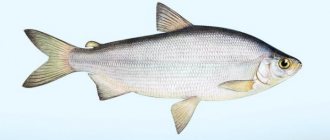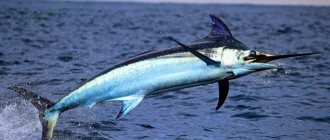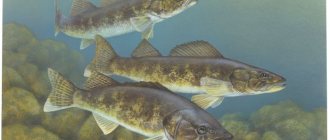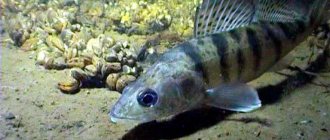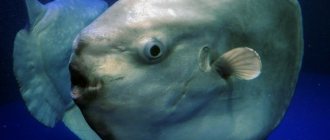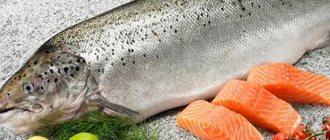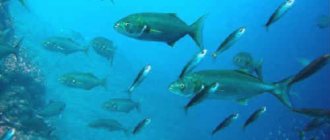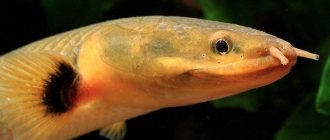Who is she and where does she live?
Who is she, Marinka fish? What kind of fish is it, what does it look like and where does it live? The nimble and dexterous marinka, although it belongs to the carp, received the nickname “trout sister” for its willful disposition and behavioral characteristics.
She lives in Central and Central Asia and Kazakhstan. In these places it is also often called “karabalyk”, which translates as black fish. Very rarely, it can be found in Ukraine and the European part of Russia. Marinka lives in almost any conditions, but is most often found in mountain rivers and lakes. It can also be found in springs among cliffs, lowland rivers, rifts and cold streams. In most of Asia, this fish fills all existing reservoirs, is considered a weed and is not particularly loved by professional fishermen.
Where and how to catch marinka?
> What to catch > Other fish > Where and how to catch marinka?
General information
Marinka is often called the trout's sister. This interesting fish mainly lives in mountain rivers, streams and lakes in Central Asia. The body shape of the marinka is spindle-shaped and elongated; the body of the fish is covered with small scales. Marinka's lower mouth has 4 antennae located near the mouth. Most often, small specimens up to 25 cm are found. However, there are individuals weighing about 4 kg and up to 60 cm long.
A large concentration of marinka is observed in small mountain rivers and streams of Nuratau (Uzbekistan). Marinka
loves fast currents and clean water, but feels quite good in muddy water. This fish is fast and agile. Experienced fishermen claim that it can easily overcome waterfalls up to 2 m high.
In the mountainous areas of Uzbekistan, marinka lives in almost all streams; it is often possible to meet it in wells with springs. To get rid of leeches, marinka is often even put into wells or springs. In reservoirs where this fish is found, the water is almost always clear and clean. In such reservoirs there are no algae and small crustaceans.
Marinka can be called an omnivorous fish; its diet includes both plant and animal foods. It is able to feed not only on larvae, insects or algae. Marinka often hunts for small fish, and also happily eats mulberries and various seeds.
Marinka spawns in May. To do this, she climbs high into the mountains to the very sources of mountain reservoirs. In this case, spawning can continue for several months. The juveniles of this fish grow quickly and gain weight, and within a year the marinka becomes sexually mature.
Fishing for marinka
always interesting and exciting, especially suitable for fans of sport fishing.
However, the fisherman must also know the habitats and behavioral characteristics of this fish. After all, Marinka is not only a strong and dexterous fish, she is also very careful. The speed and agility of Marinka can be compared with trout. It’s a pleasure to catch even a small fish; the strength of the mountain current and the resistance of the fish can give any angler an unforgettable experience. Moreover, marinka fishing
is possible throughout the year. However, the most catchy time comes when the water clears after the snow melts. During this period, the fish loses its vigilance and actively feeds. However, the clearer the water becomes, the more cautious the marinka behaves.
The best time to catch marinka begins at dawn and can last until noon. Further, the pecking activity drops sharply and Marinka begins to actively peck only when dusk comes.
Habitats
As a rule, this fish prefers shelter behind boulders or stones; it can also be found under bushes or near coastal gullies. At the same time, she does not pursue her prey, but prefers to lie in wait in a shelter. To find marinka, the fisherman must constantly move and carefully fish promising areas. Successful fishing for marinka is possible if the angler knows how to behave carefully and quietly, uses camouflage methods and knows how to make accurate casts.
How to catch?
In the same body of water, you can use several methods to catch this fish. For example, marinka is caught using a float tackle with a wire, but it can also be caught without a float. You can fish with a fly or with bottom gear. It is very convenient to catch marinkas on a rod equipped with a reel, as well as if it has guide rings. This allows the angler to increase the line release.
Typically, gear is equipped with a 0.3 mm fishing line, and the leash is made thinner than 0.25 mm. As a rule, either one or two hooks No. 4 or 5 are used. The tackle is equipped with a sliding weight. And the float is removable. As for baits and attachments, the range here is quite wide. They are caught using larvae of aquatic or flying insects and worms. And for grasshoppers, even for mulberries, which Marinka simply adores. However, the most versatile and catchy bait for catching this fish is a caddis fly larva.
They catch this fish, usually going up the river and catching places that are promising, in the fisherman’s opinion, and then, returning downstream of the river, they continue fishing the places they like. On the fisherman’s path there may be small whirlpools, gullies or backwaters that form waterfalls; it is precisely such places that attract the marinka the most.
Where there are small creeks or gullies, you can use bottom gear rather than float gear. The bait is lowered between the stones and after short intervals they begin to move it on different sides. And if at the same time the angler was careful and did not scare the prey, then the fish will show itself with a quick bite. At the same time, a push is delivered into the hands of the fisherman. It happens that the prey grabs the bait and manages to get caught in the stones. In this case, you need to show restraint and pull the rod to the sides, forcing the fish to come out of cover.
After catching 2-3 individuals do not stop in place, but move on. The bait is released in front of you and periodically raised above the bottom. Marinka's bite
during such fishing it is felt in the form of a jerk. You can't yawn here and the hook must follow instantly.
If fishing for marinka
occurs near a waterfall, the angler catches all the ledges there. This fish is strong and is able to hold on even to very small stone ledges. There she can rest after a difficult journey. In such cases, the line is left to the mercy of the current, sending the bait over the waterfall and in the process throwing the line off the reel. This can be repeated several times in a row, and then the pool is fished, which may be located below the waterfall. In such places, this fish can also be caught using float tackle. If the marinka comes off the hook after some time, you can cast again in this place. As a rule, this fish does not go anywhere, but sits in its shelter and the probability of a repeated bite is very high.
Marinka is also worth looking for in places where streams flow into mountain rivers. Therefore, it is also recommended to fish such places. Heavy bottom tackle is used to catch marinka in deep places with strong currents. It is best to use caddis flies as bait in such places. A bite can be determined by the vibration of the rod tip. Hooking is carried out at the moment when the prey lifts the bait from the bottom.
Marinka has delicious tender meat. But it is not recommended to eat its caviar; its abdominal membrane accumulates toxic substances. Before preparing marinka, the abdominal cavity should always be thoroughly cleaned of film and washed.
Published: 01/19/2017
Other interesting materials:
| Fishing in Abkhazia in freshwater reservoirs Abkhazia has always been famous for its excellent fishing opportunities. Quite... | What kind of fish is caught in August? In summer fishing, August occupies a special place. Summer heat this... | Cooking fish soup at home You know how you can prepare a quick and very tasty fish soup right at home... | Fishing in Helsinki There are many excellent and simply good places for fishing in Finland, not… |
Features of Marinka
This nimble fish prefers clean, flowing water, so most often it can be seen on small rapids and waterfalls; it overcomes them with ease. Local residents have found an original way to use marinka for their own purposes. This omnivorous fish is used to clean wells - it quickly and happily destroys all kinds of crustaceans, leeches and various vegetation there. Fish is also widely used as food.
This is where its main feature lies. The fact is that Marinka fish is poisonous. More precisely, not all fish are poisonous, but only the gills, caviar and the black film lining the inner surface of the belly. To avoid poisoning, you need to carefully remove these parts before cooking. Despite the fact that Marinka fish is poisonous (photo below), its meat is very tasty, tender and quite fatty, so learning how to properly cook this fish is a truly worthwhile endeavor.
Appearance and structure
The Marinka fish has an elongated, elongated body, covered with small dense scales, which become somewhat larger near the caudal fin. The back of the fish is gray or gray-green, and towards the lower part the shade gradually darkens on the sides, turning into black. This is a classic option, however, depending on the habitat, the color of the marinka may change. Quite often, for example, you can find pale yellow or orange fish with a greenish head. Above Marinka’s upper lip there are short but quite noticeable mustaches - there are two pairs of them, a larger one and a smaller one.
Most often, individuals are found measuring about 25–30 cm, but much larger specimens are also found. The largest ones can weigh several kilograms.
Kinds
In total, there are 4 varieties of Marinka fish, each of them differs not only in its habitat, but also in its dietary preferences.
- Marinka common. The size of this fish can reach 70–80 cm, and its weight varies from 300 grams to several kilograms. The common marinka is very omnivorous - it can feed on both algae and fry of its own species. This is the most common type of marinka, which is found throughout almost the entire territory of Central Asia.
- Pike-shaped marinka. In size and appearance, it is practically no different from the previous species, however, it prefers to eat animal food - fry, crustaceans, water bugs, and so on. It lives more often in water bodies of Turkmenistan.
- Balkhash Marinka. From the name it is clear that it is found mainly in the slightly brackish waters of Balkhash, as well as in other reservoirs of Turkmenistan. Unlike previous species, the Balkhash marinka is not so large, its dimensions rarely exceed 35–40 cm. It has quite large scales, but its mouth and mustache, on the contrary, are relatively small. Since its main food is vegetation, its meat is not as tasty as compared to its carnivorous counterparts.
- Ilyinskaya Marinka. This variety is the largest, some individuals can reach 1 meter in length. The weight of the largest individuals of the Ilyinsky marinka can fluctuate between 11–12 kg. Its distinctive feature is its rather large, luridly disproportionate head. This fish is exclusively predatory and lives, for example, in the Ili River, as well as in the Kapchagai Reservoir. Due to its former popularity, the Ilyinskaya marinka is listed in the Red Book; the last catch of this fish was recorded in the late 70s of the last century. Today they are trying to breed it artificially.
This is what Marinka fish is like. Where is this freshwater beauty found and how can you catch it? Go ahead.
Varieties
Ichthyologists distinguish 3 types of marinkas:
- ordinary;
- Iliskaya;
- Balkhash
When studying the geographical distribution of this fish, it immediately becomes noticeable that some subspecies live in closed reservoirs and have absolutely no contact with other representatives of the ichthyofauna. This eliminates the mixing of chromosomes and the appearance of hybrids. It is for this reason that marinkas can differ greatly from each other in the following indicators:
- growth rate;
- maximum weight;
- fertility.
The only exceptions are the Ili and Balkhash varieties, which often interbreed and produce hybrid forms.
Interesting! Unlike the vast majority of other fish, in the marinka population there is a predominance of males over females. The ratio is about 70/30%.
Smelt fish: description and photo
The common variety of marinka is found in the following rivers:
- Zeravshan;
- Syrdarya;
- Murgaba;
- Amu Darya;
- Tejen.
River representatives are distinguished by a pale silver color with a grayish back. In lake individuals, the back is brown, and the orange color palette predominates on the sides. The maximum length of an ordinary marinka is 50 cm, with a weight of about 1 kg.
The Ili variety inhabits the famous Lake Balkhash and the basin of its tributary, the Ili River. It also occurs:
- in Issyk-Kul;
- in the Chu River;
- in the Tarim River.
The main difference between the Ili variety and the ordinary one is size. The Ili Marinka is significantly larger. Under favorable conditions, it can grow up to 70 cm in length and weigh more than 8 kg. Its scales have a clearly visible pinkish tint.
The small marinka is not so careful, so it is much easier to catch it than a large individual of this species.
The Balkhash form differs from previously described species in several ways: large scales of dark olive or black color;
- dark fins;
- golden belly;
- green color of the head;
- shorter mustache.
Its maximum length is 80 cm, with a weight of more than 10 kg. The main habitats are lakes Balkhash and Alakol. During spawning, this species is able to climb 300 km up the Ili in search of suitable places. This has led to the fact that in this river one can find a hybrid form, which arose as a result of crossing the Balkhash and Ili marinka. Local fishermen call it “kokpas”.
Where to catch marinka
Since this fish often prefers a predatory method of feeding, it lives where it is most convenient for it to hunt.
In winter, it can be found in the estuarine areas of rivers - the depth there is sufficient, and the current is not so fast. In fast mountain rivers at this time of year, the marinka tends to go closer to the bottom; the deep currents are not so strong. She also loves to hide in the quiet backwaters of lakes.
In the summer, Marinka goes to the rapids. There, among piles of stones, in the lower reaches of rivers, she waits for her prey. The predator also likes to sit in gullies, between bushes and stones - also an excellent place for hunting.
To catch this cunning predator, the fisherman will have to observe the strictest silence and cast the gear very carefully.
Reservoirs
In winter, fishing for redfish is possible in the bottom layers of rivers with strong currents.
If hunting is carried out in deep-sea reservoirs and with moderate currents, then it can be found in estuarine areas. For fishing on the lake, it is recommended to choose quiet backwaters as a promising place.
In summer, fish go to the rapids. There is especially a lot of it in the lower reaches of rivers, where there are a lot of stones.
Often it settles in peculiar gullies, between stones and vegetation. This is a convenient place for ambushes.
The key to successful fishing for this type of fish is to follow the rules of camouflage , in particular not to create unnecessary noise and carefully cast the bait.
In addition, to catch this cunning and cautious individual, you will need not only patience, but also endurance, given that you will have to walk a lot. Finding it on mountain rivers is not so easy.
Tackle for Marinka fish
To catch this fish, they most often use a fishing rod with a float, a spinning rod with a reel and guide rings, a casting rod or a donkey - it doesn’t really matter.
But what really matters is the length of the rod. Since the Marinka fish is very shy, cautious and can see a person standing on the shore very well, you need to choose a rod with a length of at least 7 meters.
You can take a fishing line that is not too thick, about 0.4–0.5 mm, and attach a pair of No. 5 hooks to it, while leaving long, up to 30 cm, leashes. You also need to choose the right sinker; its weight depends on the depth of the reservoir and the speed of the current. For control, you can use blue or red electrical tape, wrapping it around the fishing line. This will not frighten the fish, but, on the contrary, will interest it - after all, Marinka is used to eating butterflies that have fallen into the water.
How to catch a marinka?
Marinka
(akbalyk) is a fish from the carp family.
The habitat of lakes and rivers of Central Asia is also found in Ukraine and southern Russia. It has a ridged body with small scales. The body is gray-olive or cream in color, and the fins and back are gray in color. This fish has short paired whiskers at the corners of its mouth. Body weight can reach 12 kg and length up to 1 m. The eggs of this fish are considered poisonous. Marinka is a predatory fish and on average its length is about 50 cm and its weight is 3 kg.
The largest subspecies are the Ili, Trans-Caspian and Balkhash marinka. The European part of Russia is inhabited by the common and Trans-Caspian marinka. Spawning of different subspecies of this fish often does not coincide with each other. As for the preferences of this fish, it either loves the flow of rivers where, as a rule, it hides in the bottom layers or lives in quiet areas of lakes. Mainly feeds on insect larvae, small fish and various aquatic grasses.
As a predator, the Marinka prefers a nocturnal lifestyle, and therefore the most active biting of the Marinka occurs either in the evening or at dawn. The most catchy fishing for marinka
happens during spring floods. They catch it at this time with small spoons, a bottom rod, or a float rod. Marinka is more active in the summer, but in winter its activity is much less and this fish is caught mainly in winter on bottom tackle with animal bait, primarily with fry or sliced fresh fish. Larvae and insects can also be used as bait; plant baits, primarily bread and various cereals, are less commonly used.
Fishing for marinka
possible for various tackles.
On flat sections of rivers, running or blind tackle is usually used for wiring. And in large rivers or canals with strong currents, bottom tackle with a fairly heavy load is usually used to catch this fish. As for small rivers, for marinka fishing it is better to use a lightweight spinning rod with a long leash (60-70 cm), a hook No. 6-6.5 and a weight of 15-30 grams. A fishing rod 5-6 m long is also quite suitable; sometimes it is even more convenient to use than a spinning rod. As a rule, the sinker is mounted on a separate leash to the main fishing line. Such a garter allows you to preserve the main equipment in the event of a break, especially if marinka fishing
is carried out in a mountain river, where the load often gets stuck under stones.
In the summer season, you should look for sites for this fish by moving downstream of the rivers, and the bait will have to be carried in a fast stream past large stones and boulders, in places with a sandy bottom, if the section of the river flows along a plain. This kind of fishing requires considerable physical effort, especially if you fish in mountainous areas.
As for the cold season, everything is much simpler here. Schools of marinkas move little and mostly stay in quiet and relatively deep places, which on mountain rivers are closer to their mouth.
When a marinka bites in the current, it resembles a blow, and is quite similar to the grip of a spinner by a not too large pike. The hook should be sharp, and after hooking the marinka usually tries to go under a stone or into some other shelter, or simply press down to the bottom. And even a small individual offers strong resistance, but not for too long. And if you manage to pull the prey out from under a stone or tear it off the bottom, it soon stops resisting. The marinka comes off the hook very rarely because in fast currents it swallows the bait very deeply. The main thing when playing is to allow this fish to swallow a little air, and ideally not to give it the opportunity to press down to the bottom or hide behind a boulder or under a stone. Therefore, when fishing, the line should be held vertically, this will not give the fish the opportunity to go into cover. Mostly in winter, individuals weighing 0.6-1.2 kg are caught. In summer these figures are higher.
Marinka is a fickle fish and sometimes after two or three bites it may not show activity for two hours, or maybe stop biting altogether until the next day.
Fishing for marinka in a mountain river
in winter it is quite promising, although more than 4-5 individuals are rarely caught. Even in the summer, Marinka rarely indulges in the frequency of bites. In addition, it is almost impossible to see this fish even in the purest mountain river. It is very careful, stays close to the bottom all the time, besides, it has excellent camouflage coloring, and besides, this fish never reveals its presence with a splash.
However, there are places where this fish can lose its usual caution. These are small rivers, streams and small pools that are fed by spring waters. Such pools - hauzs - are usually located near places revered by Muslims, which are called mazars. There is no fishing near these markets, and Marinka has practically ceased to be afraid of people in such places.
Sometimes you can see a picture of children feeding marinka crumbs in markets; some fish can even grab children’s fingers with their lips; their lips are soft and cannot cause harm; you can even stroke such practically “tame fish” on the back with your hand.
Fishing for marinka in mountain rivers and lakes
, naturally differs in its methods. If in a mountain river with a strong current, even in flat areas, catching this fish using bait is completely ineffective, then in lakes without bait you can hardly hope for a good catch.
They feed marinka in the lakes where they live in the same way as carp or carp. That is, before you start fishing, it is recommended that you first feed the future fishing area well for 2-3 days and only then go fishing. Local fishermen do not indulge Marinka with proprietary mixtures. Basically, bait is prepared on the basis of various porridges and oatmeal. Vanilla, coriander seeds, dill or hemp are added as flavorings.
Fishing on the marinka
, given the strength of the fish and its powerful resistance during fishing, can be a pleasure for any angler.
What to fish with
As already mentioned, the Marinka fish is quite omnivorous, so the bait for it will depend on the time of year.
In the spring, a variety of bugs, worms and moths are perfect. If you want the bite to be better, look for bait on the shore of the reservoir where you are going to fish - the fish are used to it and it will be easier to deceive it. You can find representatives of the local fauna under stones, in depressions and in coastal bushes and grass.
In summer, Marinka fishes best on various berries: cherries, grapes, mulberries. However, she also does not disdain dough and worm beetles.
By autumn, with the arrival of cold weather, predator fish require more and more meat food. Therefore, she will say “thank you very much” for bait of red worms or maggots, as well as caddis.
From the experience of experienced fishermen, we can say that the favorite food of marinka fish are crickets and small grasshoppers. Multi-colored hairy caterpillars, both live and artificial, can also be an excellent bait. Especially often, large marinka pecks at green or red caterpillars. But, perhaps, dropsy is considered a special delicacy for this fish - these are fat green larvae that can be found in the coastal mud under the bushes. However, if you don’t feel like digging in the mud, you can buy silicone analogues at a fishing store; in strong mountain currents, they are practically indistinguishable from the real thing.

